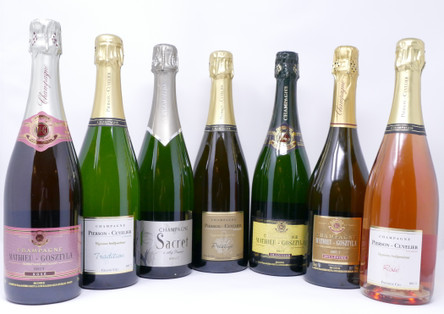Commonly Asked Questions About Champagne
Dec 7th 2020
Q. Can all sparkling wine be called Champagne?
A. No, only wines bottled in the Northern French region can use the term Champagne on their labels.
Q. How does Champagne Become Bubbly?
A. The bubbles in Champagne are made during the secondary fermentation when winemakers add a mixture of yeast, wine, and sugar to the base wine. The process releases carbon dioxide, making the bubbles you see in the finished product.
Q: Is Champagne Made with just White Grapes?
A. No, there are seven specific varieties of grapes winemakers can use to make Champagne. The list includes white grapes, Chardonnay, Petite Arbanne, Petit Meslier, Pinot Blanc, and Fromentau, as well as red grapes Pinot Noir and Pinot Meunier. Wines made exclusively with white grapes are called blac de blancs, and the less common blanc de noirs which contain only red grapes.
Q. Why do some bottles of Champagne show the vintage while some do not?
A. Consumers assume that the vintage or the year that a bottle of Champagne was harvested and produced will be on the bottle like other wines. This is not the case with Champagne. A good bottle of Champagne can be either vintage or non-vintage. A non-vintage Champagne is made from blending wines made with grapes harvested from different years. On-the-other-hand vintage champagne comes from a single harvest period and there is no blending of grapes to improve quality.
Q. What is the correct way to open a bottle of Champagne?
A. Since Champagne is bottled under pressure, there are a few tips that can help release the cork safely, and without losing any of your bubbly. After you remove the bottles foil and wire care, keep a thumb-firmly-pressed on top of the cork and slowly twist the base of the bottle. The cork will loosen gradually until it finally releases, emitting a soft hiss or a popping sound once uncorked.
Q. What is the secret to keeping an open bottle of Champagne Bubbly?
A. When left with an open bottle of Champagne, keep the bottle opening sealed with a high-quality Champagne Stopper to prolong its effervescence. When a bottle is well sealed it will keep its bubbles for three to five days when refrigerated.
Q. Does Champagne Pair Well with Food.
A. Absolutely, Champagne pairs well with many types of food. For example, our Sacret Blanc de Blanc Champagne goes great with eggs benedict or a spinach- frittatas during brunch. It is ideal when served with any type of fish or sushi. Our Mathieu-Goszytla Brut Rose de Saignee is a great alternative to red wines as it can be served with chicken or steak, and when serving hors d’oeuvres, or decadent desserts you can’t go wrong serving our Sacret Rose Champagne.
Q. What is the best glass to serve Champagne in?
A. Traditionally, Champagne is served in a Champagne flute. Its tall, thin form showcases and preserves the bubbles beautifully. If you do not have Champagne flutes, then you can use a white wine glass.
Q. What is the best temperature to serve Champagne?
A. The ideal serving temperature is 8- 10 degrees Celsius
Q. Is Champagne just for special occasions?
A. While it’s true that most people consume Champagne on special occasions, such as weddings, anniversaries, and holidays, it is appropriate to serve for virtually any occasion.
At Club Jeroboam many of our Champagne products have been exclusively procured from our winemakers in Champagne, France, and Northern Spain. To experience these premium products for your-self we invite you to join our exclusive Club Cuvée, wine club membership.

